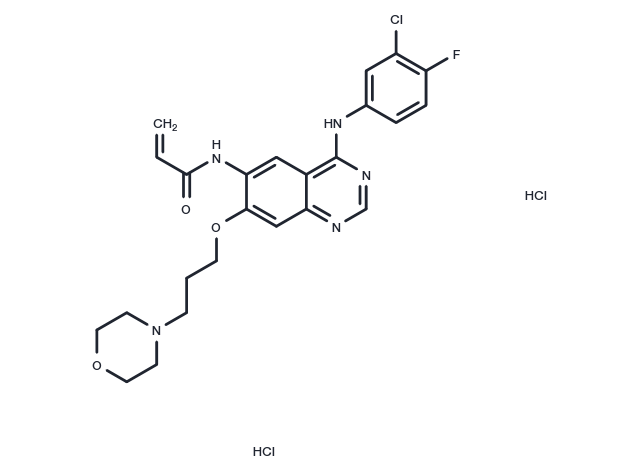Powder: -20°C for 3 years | In solvent: -80°C for 1 year


Canertinib dihydrochloride (PD-183805 dihydrochloride) is the hydrochloride salt of an orally bio-available quinazoline with potential antineoplastic and radiosensitizing activities.

| Pack Size | Availability | Price/USD | Quantity |
|---|---|---|---|
| 5 mg | In stock | $ 32.00 | |
| 10 mg | In stock | $ 48.00 | |
| 50 mg | In stock | $ 68.00 | |
| 1 mL * 10 mM (in DMSO) | In stock | $ 47.00 |


| Description | Canertinib dihydrochloride (PD-183805 dihydrochloride) is the hydrochloride salt of an orally bio-available quinazoline with potential antineoplastic and radiosensitizing activities. |
| Targets&IC50 | EGFR:7.4nM, ErbB2:9 nM |
| Kinase Assay | Kinase inhibition: Cediranib is dissolved in DMSO at a concentration of 10 mM. All enzyme assays are run at, or just below, the respective Km for ATP (0.2 - 30 μM). The inhibitory activity of Cediranib is determined against a range of recombinant tyrosine kinases [KDR, Flt-1, Flt-4, c-Kit, PDGFRα, PDGFRβ, CSF-1R, Flt-3, FGFR1, Src, Abl, epidermal growth factor receptor (EGFR), ErbB2, Aurora A, and Aurora B] using ELISA. Selectivity versus CDK2 and CDK4 serine/threonine kinases is examined using scintillation proximity assays with a retinoblastoma substrate and [γ-sup>33P]ATP. Activity of Cediranib is compared to MAPK kinase (MEK), which shows dual specificity. It is determined using a MAPK substrate, [γ-33P]ATP, and paper capture/scintillation counting. |
| Synonyms | CI-1033 dihydrochloride, PD-183805 dihydrochloride, Canertinib |
| Molecular Weight | 558.86 |
| Formula | C24H27Cl3FN5O3 |
| CAS No. | 289499-45-2 |
Powder: -20°C for 3 years | In solvent: -80°C for 1 year
DMSO: 55.9 mg/mL(100 mM)
You can also refer to dose conversion for different animals. More
bottom
Please see Inhibitor Handling Instructions for more frequently ask questions. Topics include: how to prepare stock solutions, how to store products, and cautions on cell-based assays & animal experiments, etc.
Canertinib dihydrochloride 289499-45-2 Angiogenesis JAK/STAT signaling Tyrosine Kinase/Adaptors EGFR ErbB-1 PD 183805 CI-1033 dihydrochloride PD 183805 Dihydrochloride PD-183805 dihydrochloride Orthopoxvirus PD-183805 CI 1033 Dihydrochloride PD183805 Dihydrochloride PD183805 CI1033 Dihydrochloride Epidermal growth factor receptor CI 1033 PD-183805 Dihydrochloride Inhibitor CI1033 Canertinib inhibit HER1 CI-1033 Canertinib Dihydrochloride CI-1033 Dihydrochloride inhibitor
